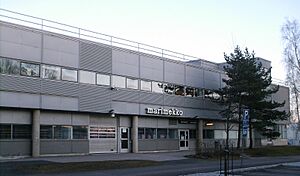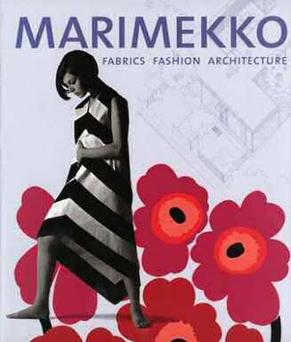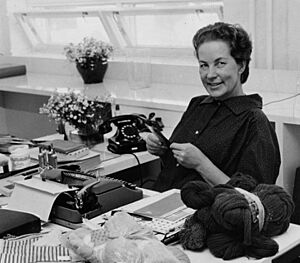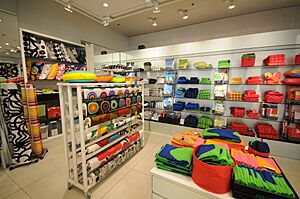Marimekko facts for kids
Logo since 1954
|
|

Head office
|
|
|
Native name
|
Marimekko Oyj
|
|---|---|
| Public (Julkinen osakeyhtiö) | |
| Traded as | |
| ISIN | [https://isin.toolforge.org/?language=en&isin=FI0009007660 FI0009007660] |
| Industry | Textiles Clothing Home furnishings Retail |
| Founded | 25 May 1951 in Helsinki, Finland |
| Founders | Viljo Ratia Armi Ratia Riitta Immonen |
| Headquarters |
Helsinki
,
Finland
|
|
Number of locations
|
153 stores (2022) |
|
Area served
|
Worldwide |
|
Key people
|
Tiina Alahuhta-Kasko (CEO) Mika Ihamuotila (Chairman) Maija Isola (Designer) Vuokko Nurmesniemi (Designer) |
| Revenue | |
|
Operating income
|
|
|
Number of employees
|
|
Marimekko Corporation (Finnish: Marimekko Oyj) is a famous Finnish company. It makes textiles, clothes, and items for your home. Viljo and Armi Ratia started the company in Helsinki in 1951. Marimekko became very important in fashion during the 1960s. It is known for its bright, colorful fabrics with cool patterns. They use these fabrics for women's clothes and home decorations.
Two special designers, Vuokko Nurmesniemi and Maija Isola, helped make Marimekko famous. Nurmesniemi created bold stripes. Isola designed large, simple flower prints, like the Unikko poppy pattern. These designers made hundreds of unique patterns. Their work helped Marimekko become a well-known name around the world.
Contents
What Does "Marimekko" Mean?
Armi Ratia, one of the founders, first thought of using her own name, Armi, for the company. But that name was already taken. Her middle name was Maria, which people often shortened to Mari. Her husband, Viljo, was thinking of different names for women's clothing. In Armi's hometown, Koivisto, she heard people talking about dresses (Finnish: mekko). So, she put Mari and mekko together to create the name Marimekko.
Marimekko's Story
How Marimekko Started

Marimekko began in 1951. Viljo and Armi Ratia started it after Viljo's oil-cloth factory didn't work out. They changed the factory into a place to make clothes. Armi asked her artist friends to put their graphic designs onto fabrics. To show how these fabrics could be used, the company then designed and sold simple dresses made from their own material.
In 1957, a famous Finnish industrial designer, Timo Sarpaneva, invited Marimekko to show their designs at a big event in Milan, Italy. This was an early sign that Marimekko was important in shaping fashion. Even though the fashion show was canceled, the clothes were still shown in a fancy department store by Giorgio Armani.
Famous Designs and Growth
Two designers were key to Marimekko's style: Vuokko Nurmesniemi in the 1950s and Maija Isola in the 1960s. Nurmesniemi designed the simple red and white striped Jokapoika shirt in 1956. Isola created the very famous Unikko (poppy) print pattern in 1964. Marimekko's bold fabrics and bright, simple designs had a big impact on style in the late 1900s. Many of these early Marimekko designs, including Isola's Unikko, are still made today.
Marimekko became popular in America in the 1960s. An architect named Benjamin C. Thompson brought their products to his stores. They became even more famous when Jacqueline Kennedy, who would become the First Lady, bought eight Marimekko dresses. She wore them often during the 1960 United States presidential campaign.
By 1965, the company had over 400 employees. Marimekko was involved in many areas of design, from fabrics to toys and dishes. They even furnished small houses completely. In 1985, the company was sold to another group called Amer-yhtymä.
In the early 1990s, Marimekko faced money problems and was almost bankrupt. Kirsti Paakkanen bought the company from Amer. She brought in new ways of doing business and helped Marimekko become popular again.
Later in the 1990s, Marimekko gained attention from the popular TV show ... and the City. A character on the show, Carrie Bradshaw, wore a Marimekko bikini and later a Marimekko dress. In a later season, the show featured tablecloths with Marimekko prints.
By 2005, Marimekko's sales had grown four times since Paakkanen bought it. Its profits had increased by 200 times. Paakkanen remained the CEO and owned a large part of the company. In 2007, she announced that Mika Ihamuotila would gradually take over as CEO and the main owner. By 2011, there were 84 Marimekko stores around the world.
Today, Marimekko products are made in countries like China, India, Thailand, Portugal, and Lithuania. The fabrics are printed at Marimekko's own factory in Helsinki, Finland, but the raw materials are not made there. In 2021, the company celebrated its 70th anniversary. They published a book called Marimekko: The Art of Printmaking.
Marimekko's Logo
The Marimekko logo has been used since 1954. Armi Ratia wanted the logo to be simple and timeless. A graphic designer named Helge Mether-Borgström created the logo. He used changed versions of letters from classic Olivetti typewriters to design it.





